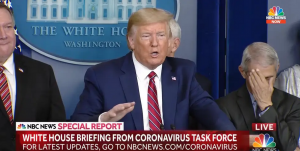Isolation Tips: Coping With Long, Annoying Commercials
Remember that bit you used to do in the 90s about being trapped in an elevator with Donald Trump? It’s not funny anymore.

Lisa Van Dusen/For The Hill Times
May 7, 2020
In this latest of my series of intermittent public service columns on how to cope with life in pandemic isolation, we’ll tackle the conundrum of how to manage confinement coexistence with Donald Trump.
In our old-timey lives, when escape from the hourly onslaught of Trumpian nonsense was just that third trip to the store in one day that you couldn’t remember the reason for once you were busted by a “Bonjour” while wandering catatonically through the bathroom fixtures at Canadian Tire, we didn’t need a system.
Now that the world is one big captive audience trapped with the nightly COVID-19 advisory stylings of a man touting the anti-viral benefits of Clorox ingestion, it’s time to adapt.
As someone whose job requires her to process a weekly minimum of information about the activities of America’s first rogue-state president, I’ve developed an avoidance technique that, if you don’t happen to be professionally chained to the rhythm of the relentless gavage of Trumpaganda, may be useful for general application.
Become the master of your mute. The mute button was invented in 1956 by Robert Adler, an engineer working for the Zenith Radio Corporation in Chicago on the first commercially available TV remote. (Robert Adler was no apparent relation to fellow Austrian Alfred Adler, founder of the compensation-focused Adlerian school of psychotherapy, whose Adler button may be more useful to this endeavour.) Robert Adler invented the mute button—per a 2019 Guardian exposé that managed to expend more than 1,000 words on the renaissance in muting without once mentioning its most obvious political value—at the request of his boss, Eugene McDonald, a former naval intelligence officer who hated “long, annoying commercials.” That this is precisely the purpose for which we have now assigned the mute button a special therapeutic function is one of those rare instances of historical kismet—say, the opposite of a reality show host playing the worst president in history comparing himself to Abraham Lincoln.
I’ve taken the liberty of writing an algorithm that identifies which keywords in any presidential COVID-19 briefing should trigger your activation of the mute button for maximum peace of mind based on data inputs gathered from more than 6.4 minutes of raw Trump video and outputs carefully curated for maximum efficiency and minimum margin of error. Those keywords are, “I,” “We,” “And,” “The,” “Well,” “It,” “But”, “Maybe”, “You’re”, and “Jynah.”
When any of these words occurs at the beginning of a Trumpian sentence, hit mute immediately and go back to watching that TikTok of Jack Black’s Topless Cossack-Cowboy 30-second workout video on your laptop, tablet, or handheld device. Note that this particular coping mechanism only works on troublesome roommates or gamy relatives if you happen to be on a Zoom call with them—an avoidance technique ably demonstrated by Canadian MPs in their inaugural virtual Parliament last week.
In order for this system to work efficiently, you’ll need to make sure you have a secure supply of fully charged AA batteries, because if you find yourself with an expired battery at precisely the wrong mute moment on a Tuesday that isn’t your quarantine-breaking, bleach-foraging, designated expedition day, you’ll be cursing me for not reminding you once the words keep tumbling out in an avalanche of bollocks before you can pull yourself together sufficiently to scramble over and unplug the television.
If, like me, you need, for professional reasons, to compensate for your therapeutic muting by relying on second-party sources to stay abreast of any major, significant Trumpian policy developments of any consequence whatsoever on a weekly basis, just Google “Trump policy” on Fridays at noon and process the details in convenient pre-digested print form.
Believe me, it won’t take long.
Lisa Van Dusen is associate editor of Policy Magazine and a columnist for The Hill Times. She was Washington bureau chief for Sun Media, international writer for Peter Jennings at ABC News, and an editor at AP in New York and UPI in Washington.
